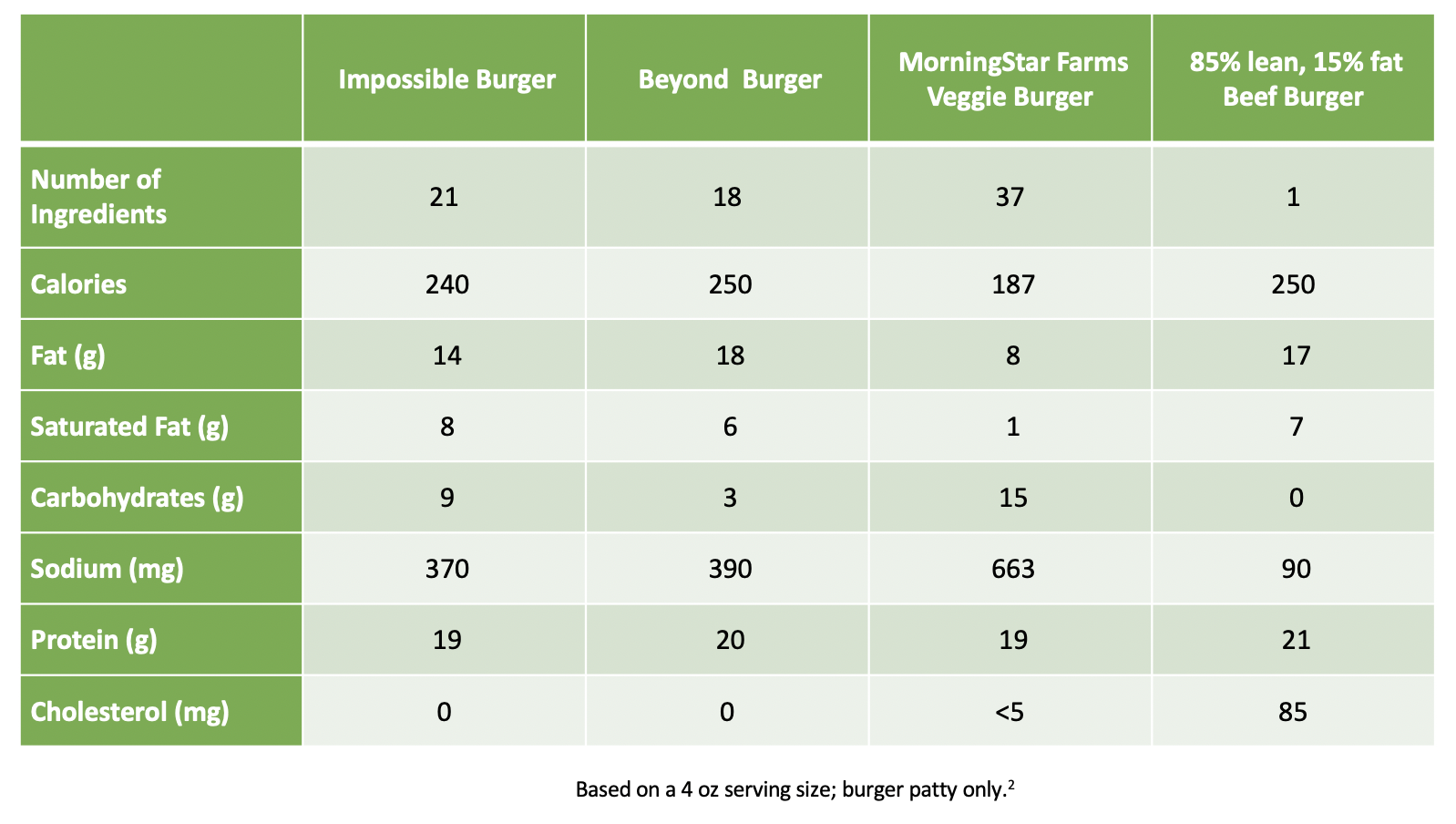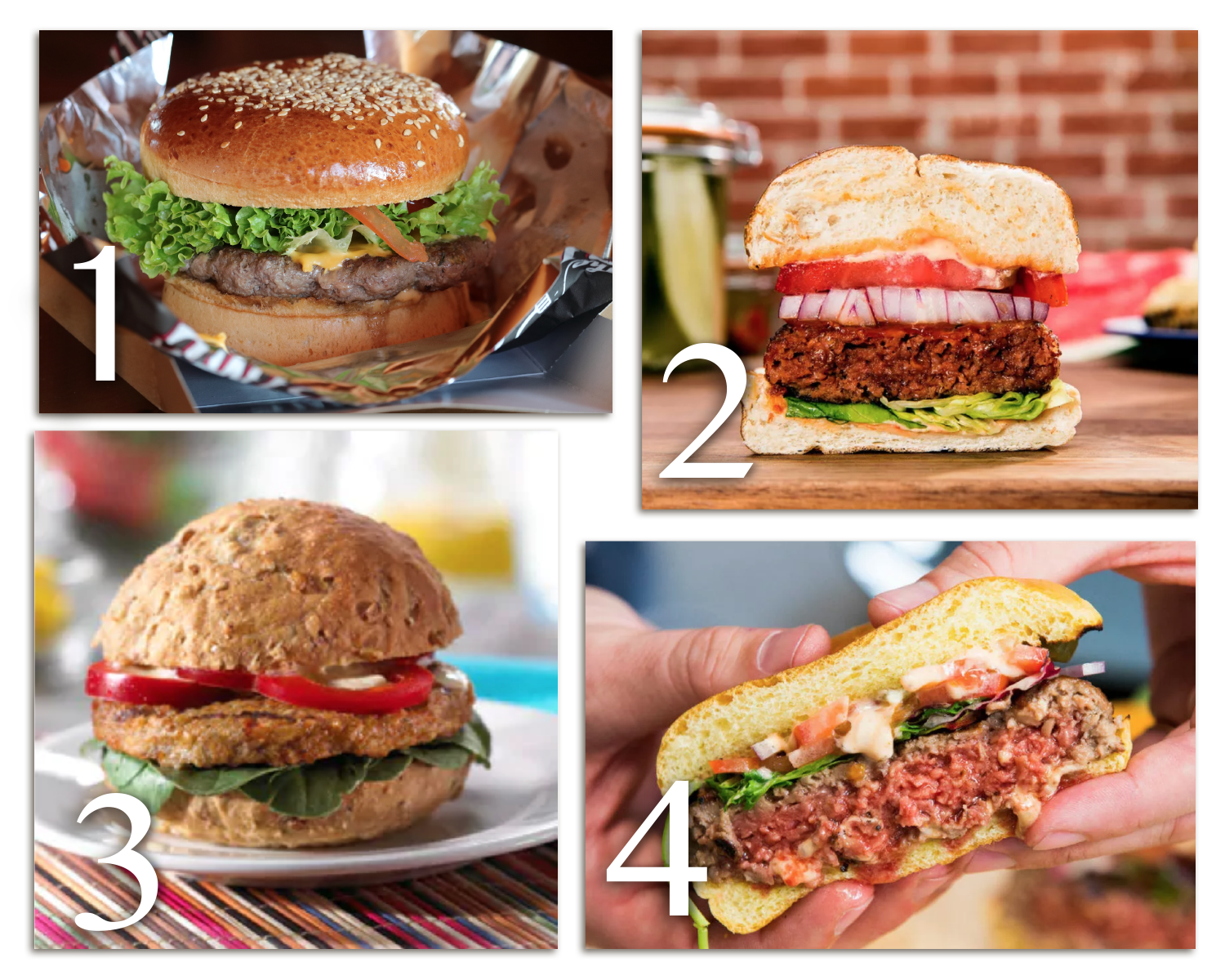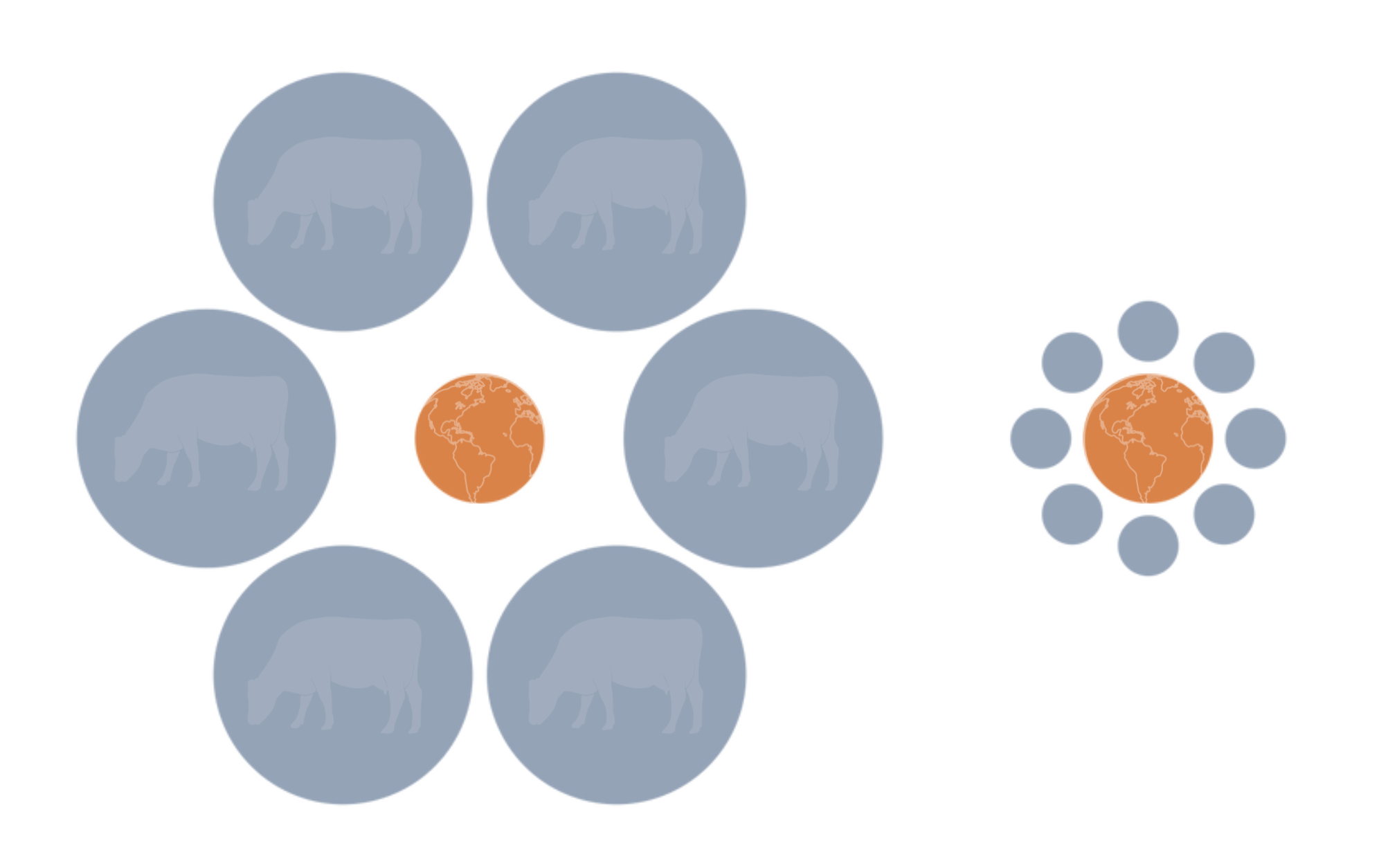Agricultural Literacy Curriculum Matrix
Lesson Plan
A Tale of Two Burgers: Beef and Plant-based Protein
Grade Level
Purpose
Students compare the components of beef and plant-based burgers by determining the production and processing methods of each product; evaluate the ingredients and nutritional differences between beef and plant-based products; and discuss different points of view in the agricultural industry concerning plant-based proteins and traditional beef. This lesson covers a socioscientific issue and aims to provide students with tools to evaluate science within the context of social and economic points of view. Grades 9-12
Estimated Time
Materials Needed
Engage:
- Meat or Meatless? slide deck
Activity 1: Gallery Walk
- Burger Gallery Walk activity sheets (1 copy for a small class, 2 copies for a larger class)
- Large poster paper (1 per group)
- Markers
- Sticky notes
Activity 2: Burgers From Different Points of View
- Points of View- Plant-based Burger cards (1 copy per class)
- Beach ball or soccer ball
Activity 3: Will Eating Less Meat Save the Planet?
Vocabulary
Beyond Burger : a plant-based alternative that looks and cooks like beef, but does not contain heme or soy
burger: a round patty of ground beef or plant-based products
genetically engineered (GE): an organism or crop whose characteristics have been deliberately modified by manipulating its genetic material
hamburger : ground beef; a common name for beef burgers
heme: an iron-containing molecule found in every living plant and animal that looks and tastes like blood
Impossible Burger : a plant-based alternative to traditional beef burgers that contains heme and mimics the flavor, aroma, and texture of beef
leghemoglobin : an oxygen carrier and hemoprotein found in the nitrogen-fixing root nodules of leguminous plants
meat: the muscle of an animal used as food
yeast: a microscopic fungus consisting of single oval cells that reproduce by budding, and are capable of converting sugar into alcohol and carbon dioxide
Did You Know?
- May 28th is National Hamburger Day
- Americans eat an estimated 50 billion hamburgers each year.9
- Gregory Sams is credited for creating the first commercially sold “VegeBurger” (veggie burger) in 1982.10
Background Agricultural Connections
Plant-based protein is on the rise and alternative burgers are showing up on fast-food menus. As more and more meatless alternatives become available, consumers may be faced with various questions and concerns. What is a plant-based burger? How does the Impossible Burger compare to a Beyond Burger? Are meatless burgers a healthier alternative?
Many consumers have enjoyed plant-based proteins—like veggie burgers—for years, but why the sudden surge of popularity? Companies like Impossible Foods and Beyond Meat have revolutionized the plant-based industry by creating meatless burgers that actually look, cook, smell, and taste like beef. These taste- and lookalike burgers also come advertised as a more environmentally friendly protein alternative, and a possible solution to feeding our growing population.
Beef
Humans began eating beef (domesticated cattle) in 6,500 B.C. Beef cattle have since played an important role in agricultural production. Because of their ruminant digestive system, cows have the unique ability to upcycle human-inedible forages and byproducts. Feeds like grass, cottonseed meal, and distillers’ grain are upcycled into high-quality cuts of protein, iron, and zinc. What most consumers don’t realize is that all cattle spend the majority of their lives eating grass and forage products. Calves are raised with their mother on pasture or grass until they are between 6-12 months of age. After weaning, cattle are then fed grain and/or more forages to a finishing weight (1,200-1,400 pounds) for harvesting. A 1,200-pound steer will produce about 500 pounds of meat including steaks, roasts, and ground beef.5 The remaining byproducts from the beef carcass are used for common objects such as leather, pet foods, cosmetics, detergents, glue, and brake fluid.
The Beyond Burger
Beyond Meat began in 2009 and their plant-based “Beyond Burger” debuted in 2016. The protein in a Beyond Burger comes from a combination of pea, mung bean, and rice protein. The red color of the meat—to resemble beef—comes from beets. Other ingredients in this popular patty include water, expeller-pressed canola oil, refined coconut oil, natural flavors, cocoa butter, methylcellulose, potato starch, apple extract, salt, potassium chloride, vinegar, lemon juice concentrate, sunflower lecithin, and pomegranate fruit powder. Beyond Meat advertises a plant-based protein that is soy, gluten, and GMO free.
The Impossible Burger
Impossible Foods was founded in 2011 and their plant-based “Impossible Burger” first hit fast-food menus in 2019. The Impossible Burger is a stand-out from other plant-based burgers because the burger patty “bleeds” like a regular beef burger. This is done using an iron-containing molecule found in every living plant and animal known as heme. Scientists discovered that heme is what gives meat its aroma and flavor. It is also what humans crave when eating meat. Soy leghemoglobin (legume hemoglobin) is a protein found in plants that carries heme. In the past, researchers at Impossible Foods harvested leghemoglobin directly from the roots of soy plants; however, they soon realized they could produce much more leghemoglobin using fermentation. Leghemoglobin is now harvested using a yeast engineered with the gene for soy leghemoglobin. The genetically engineered yeast ferments and multiplies, creating large amounts of soy leghemoglobin which contains heme. The heme is then isolated from the yeast and mixed with other ingredients to create the meaty flavor in the Impossible Burger. This process of using genetically engineered yeast allows Impossible Foods to produce heme on a large scale without digging up soy roots, promoting soil erosion, and releasing carbon from the soil.11
Other ingredients mixed with the soy leghemoglobin (heme) include: water, soy protein concentrate, coconut oil, sunflower oil, natural flavors, 2% or less of: potato protein, methylcellulose, yeast extract, cultured dextrose, food starch modified, salt, soy protein isolate, mixed tocopherols (Vitamin E), zinc gluconate, thiamine hydrochloride (Vitamin B1), sodium ascorbate (Vitamin C), niacin, pyridoxine hydrochloride (Vitamin B6), riboflavin (Vitamin B2), Vitamin B12.12
Are plant-based burgers a healthier alternative?
There are many burger options available to consumers whether they are plant-based or made from beef. While plant-based and meatless burgers are a good alternative, they might not meet the same amino acid, vitamin, mineral and antioxidant levels that are found in an eight-ounce piece of red meat.2 Consumers can get 100% of the daily intake of vitamin B12 from one serving of red meat, while a Beyond Burger will account for 20% of the daily intake of B12.2 The sodium content of each burger varies as well. A Beyond Burger contains 380 milligrams (mg) of sodium, the Impossible Burger contains 370 mg of sodium, and a freshly ground beef burger (85% lean) contains 90 mg of sodium.2 Plant-based burger patties, however, contain significantly less cholesterol when compared to a beef patty. Consumers should be aware of the production and processing methods of each burger, as well as ingredients and nutrient content so they can select a burger that fits their dietary needs and preferences. Those who are allergic to soy should avoid eating plant-based products that contain soy leghemoglobin.


Engage
- Project the Meat or Meatless PowerPoint on the board. Show slide 1 with four photos of different burgers.

- Ask students to number 1-4 on a piece of paper.
- Instruct students to evaluate each burger and try to correctly match the picture to the type of burger it is.
- Once students have selected their matches, have them prepare supporting statements and reasonings for their choices.
- Using random selection, ask various students to share their guesses and reasonings with the class.
- Consider asking the following questions to lead a class discussion as students offer their reasonings:
- What qualities of the burger did you consider when studying each burger?
- Was there one burger that was easy or obvious to identify?
- Which burger would you be willing to try?
- Reveal the correct burgers (slide 2) to the students. Did anyone guess all four correctly?
- Discuss similarities and differences between the four burger options.
- Consider asking the following questions to lead a class discussion:
- Do you think all four burgers (patties) taste the same?
- The Impossible Burger is plant-based, but well-known for “bleeding” like a real beef patty. Why is that?
- How does each meat compare nutritionally?
- Inform students that they will explore meat and meat alternatives in order to determine similarities and differences between the two.
Explore and Explain
Activity 1: Gallery Walk
- Divide the class into groups of four students. Give each group one Burger Gallery Walk activity sheet. Inform students that the burger found on their activity sheet is the type of burger they will be researching.
- Note: For a medium or large class, more than one group should be assigned the same burger to keep the groups in a functional size.
- Supply each group with a large chart or poster paper, markers, and access to the internet for research.
- Instruct students to research their assigned meat/meat alternative. Remind students to use credible sources online for research. Ask students to consider and include the following information on their poster (also outlined on their activity sheets):
- How long has this meat/meat alternative been available?
- How is it produced? (e.g. beef cattle are typically raised in feedlots where their diet consists of corn and grain. When the animal reaches 1,200-1,400 pounds, it is harvested for meat.)
- What are the benefits of producing and consuming this type of burger?
- What are the challenges to producing this type of burger?
- What are the ingredients used to make this burger?
- Encourage students to make their posters visually appealing for the gallery walk. Ask students to include pictures, diagrams, timelines, and anything else that helps answer the questions.
- As students finish their posters, have each group display their work on a wall somewhere in the classroom. When everyone is complete, the students will participate in a gallery walk. During the gallery walk, students will ask questions and provide feedback to other groups.
- To set up the gallery walk, split each group in half. Two of the students from each group will walk through the gallery. The other two students will remain by their group poster. The rotating students will evaluate other posters in the classroom and discuss similarities and differences between their meat or meat alternative.
- Note: If you have two groups assigned to each type of burger, conduct a separate gallery walk rotation for each set of four burgers. This will ensure that each group only sees each type of burger once.
- Provide each group with sticky notes. Students rotating through the gallery should use sticky notes to ask questions or provide feedback about other posters. Instruct students not to repeat comments and questions already found on each poster. Each comment should be unique.
- Determine a time limit for each group rotation (about 3-5 minutes) and allow students to rotate through all the posters in the gallery until they have visited all four types of burgers.
- Ask the students who participated in the gallery walk to now switch with the other two members of their group. These students will now complete the gallery walk the same way.
- After everyone has completed the gallery walk, bring the class back together for a class discussion. Using slides 3-6 on the PowerPoint, review each of the meats with the class.
- Allow students to improve and update their posters, if needed.
Activity 2: Burgers From Different Points of View
- Write the numbers 1-6 on a beach ball or soccer ball.

- Now, stand in the middle of the room and hold the ball up for your students to see. Without rotating the ball, ask students in various points of the room which numbers(s) they can see. For example, ask a student in the front of the classroom what number he or she sees, followed by the same question to a student in the back of the room and so on. Each student will see all or part of different numbers.
- Ask your students, “Why, if you are all looking at the same object (the ball), are you seeing different numbers?” Explain that it is because each has a different “point of view.” Each student sees different numbers from their point of view. They may see an entire number or part of a number. There will be some numbers that they do not see at all.
- Use this object lesson to spring into a discussion about plant-based burgers and beef burgers.
- Ask students, “What different points of view should be considered when discussing plant-based burgers and beef burgers? How could this be a controversial topic?”
- Allow students to share and discuss different points of view related to plant-based protein and traditional beef.
- While holding the ball in the middle of the room, divide students into six groups based on where they are sitting. Ask each group which number they see best from their position in the classroom. The number that they see will be their assigned point of view. For example, if a group sees the number two best from their position in the classroom, they will have card #2 and their point of view will be a beef producer.
- Using the Plant-based Protein Point of View cards, assign each group a point of view to consider.
- Instruct groups to study the information on their card and discuss their point of view as a group. What other facts and information could be added to support their point of view? Groups should research their point of view and find various artifacts (e.g. video clips, news articles, opinion articles, etc.) that would help defend their point of view in a presentation or class discussion.
- Note: If time is short, the information on the card should give them the baseline information that they need.
- Allow students to present their material (point of view) to the class or set up your desks for a classroom discussion on each of the different points of view.
- As each group presents or discusses their point of view, remind students of the following:
- It’s okay to agree to disagree.
- When looking at or discussing issues, people may use facts, opinions, or personal biases to defend and persuade others to see her or his point of view.
- Resolving issues and evaluating situations requires that we look at the viewpoints of others to arrive at workable solutions, to form realistic conclusions, or to make our own evidence-based decisions.
Activity 3: Will Eating Less Meat Save the Planet?
- Project the Circles Illusion image on the board.

- Ask students, “Which orange circle is larger?” Most students should point to the orange circle on the right.
- Explain to students that each of the orange circles are actually the same size.
- Ask students, “Why does the orange circle on the right appear to be larger?”
- Students should conclude that it has to do with perspective and how the orange circles are presented to us. The orange circle on the left is surrounded by larger circles spaced far apart, and the orange circle on the right is surrounded by small circles that are very close together. This makes our eyes think the orange circles are different sizes, even though they are not.
- Explain to students that perspective (and the way something is presented to us) can affect the way we view something—not just an image on paper, but an issue or problem in society as well.
- Direct your students back to the illusion image.
- Ask your students to now consider the cow and earth silhouettes on the circles. After discussing different points of view during activities 1 and 2, ask students the following questions to lead into a class discussion:
- What do you see/hear about eating beef and its effect on the earth and environment?
- Just like the circles in the image, can our perspective on something be altered or skewed?
- One belief is that eating less meat will save the planet. If all of us adopt a vegetarian diet or vegan lifestyle, will that save the planet?
- Pass out one Will Eating Less Meat Save the Planet? graphic organizer to each student.
- Show Eating Less Meat Won’t Save the Planet. Here’s Why to students. This activity can be done 1 of 2 ways:
- Option 1: Watch the entire clip as a class and ask students to fill out the graphic organizer (answer each question) individually. Pause the video to check for understanding and ask questions. Encourage students to look for bias and identify types of bias if they find it.
- Option 2: Divide the students into 12 groups/pairs and assign each group a question on the graphic organizer. Next to each question is the time frame from the video clip where that question will be answered. Have each group watch their assigned time frame and answer their question. When all groups are finished, have each group share their questions and answers with the rest of the class.
- Discuss the video clip with students and lead a class discussion.
- Referring back to the illusion image ask, "What are examples of how the presentation of statistics impacts the evaluation of the environmental impact of beef in our diet?" (Measuring green water as part of the water footprint of beef, systems used to measure carbon emissions, viewing the food livestock eat as food humans can eat, etc.)
- How do we know if statistics online are being presented to us accurately? (Discuss strategies for identifying credible resources.)
- What facts or perspectives surprised you when presented in this context?
Teach With Clarity
This lesson discusses socioscientific issues concerning diet, the environment, and climate change. It includes reasoning that is based on science, but perspectives are also impacted by a degree of moral reasoning and an evaluation of ethics. To take this lesson a step deeper, guide students in evaluating a video made in response to the video Eating Less Meat Won’t Save the Planet. Here’s Why. This second video presents arguments why eating less meat will save the planet. In response to this second video, the producer of the first video posted rebuttals (as PDFs) to these arguments. These videos and the rebuttals provide an opportunity for critical thinking using a debate format. Consider using the Tale of Two Burgers—Evaluating Perspectives debate flowchart, the links to the videos and rebuttal PDFs are available in this printable flowchart and fillable PDF flowchart, as a guide to further investigate these socioscientific issues. Instruct students to take notes on the same topics in each column to create a linear flow across the page. Students should take time to make their own reflections of each video blogger and consider using Google Scholar to find additional peer-reviewed articles. Have students highlight the most credible arguments and write a summary paragraph.
- Wrap up the class discussion and remind students to check for credible sources on articles or videos posted online. Explain to students that some facts or statistics might be presented to us in ways that can alter our view or perception—just like the circles in the image.
Elaborate
- Conduct a blind taste test with students to see if they can identify which burger contains a beef patty and which contains an alternative meat patty. Burgers could be obtained from a local fast-food restaurant if time and distance allows.
- Using the Compliments of Cattle poster, introduce students to all of the by-products we obtain from cattle. Discuss a hypothetical situation. If plant-based burgers decreased (significantly) the raising of cattle for beef, what other every-day items could be impacted?
- Listen to the AgFuture podcast, Alternative "meat" vs. traditional beef - Amanda Radke. Discuss the topics addressed in the podcast. Consider the following questions to engage your students in the podcast:
- Why is consumer choice important? How does it relate to beef vs. plant-based proteins?
- Plant-based proteins are advertised as environmentally and ethically superior to beef? Is this true?
- Why can't the land used to graze cattle simply be converted to farm land to grow food?
- What by-products would be lost if the cattle industry declined?
- Should alternative meat companies be able to call their products "meat" or "beef?" Why or why not?
- Show the video, Heme - The Magic Ingredient in the Impossible BurgerTM for students to learn more about one ingredient in the Impossible Burger that makes the plant-based burger more closely resemble a beef burger.
Evaluate
After conducting these activities, review and summarize the following key points:
- Beef and the ingredients contained in plant-based burgers are produced on farms.
- The production of all food requires the use of natural resources such as arable land, water, and soil nutrients.
- Food production systems are influenced by consumer choices.
- There are many points of view to consider when comparing beef and plant-based burgers. Topics of consideration include ethics, available natural resources, nutrition, and food safety.
Sources
- What's in a Name? In This Case, Quite a Bit | Dirt to Dinner
- Comparing Traditional & Alternative Burgers | Dirt to Dinner
- Home | Meat Institute
- Is a Plant-Based Diet Better for You? | Dirt to Dinner
- How Much Meat to Expect From a Beef Carcass PB1822.pdf | University of Tennessee Extension
- Impossible Foods Media Kit | Impossible Foods
- Impossible Foods
- Beyond Burger | Vegan Burger Patties | Beyond Meat
- July 4th Hot Dog and Hamburger Consumption by State | USA Today
- The History of the Veggie Burger | Smithsonian Magazine
- How do you make heme? | Impossible Foods
- What are the ingredients in Impossible™ Beef Meat From Plants? | Impossible Foods
- What are the nutrition facts for Impossible™ Beef Meat From Plants? | Impossible Foods
- Great Value Beef Burgers 85% Lean/15% Fat, 12ct, 3 lb (Frozen) | Walmart
Recommended Companion Resources
- America's Heartland: Riding the Range on a Utah Cattle Drive
- An Unusual Snack for Cows, a Powerful Fix for Climate
- Beef Ag Mag
- Compliments of Cattle Poster
- Cows and Climate
- Have a Ball – Your Sphere of Influence
- Meat Cut Fact Cards
- Our Beautiful Planet: The Climate Secrets of Cows
- What is Sustainable Agriculture?
- Where Does Your Cheeseburger Come From?
- Who Makes the Best Burger?
- Why Can a Cow Eat Grass? Video
Author
Organization
| We welcome your feedback! If you have a question about this lesson or would like to report a broken link, please send us an email. If you have used this lesson and are willing to share your experience, we will provide you with a coupon code for 10% off your next purchase at AgClassroomStore. |
